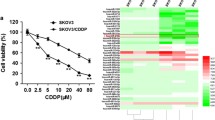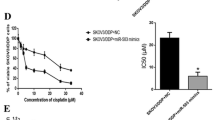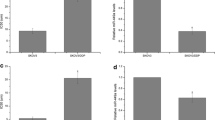Summary
Chemotherapy is the preferred therapeutic approach for advanced ovarian cancer, but a successful long-term treatment is prevented by the development of drug resistance. Recent works have underlined the involvement of non-coding RNAs, microRNAs (miRNAs) in cancer development, with several conjectures regarding their possible involvement in the evolution of drug resistance. This study is to investigate the promoting effects and mechanism of miR-125b involved in the development of chemoresistance in ovarian cancer. The different expression of miR-125b in cisplatin-sensitive ovarian cancer cell line (OV2008) and its resistant variant (C13*) was identified by real-time PCR. An in vitro cytotoxicity assay and apoptosis assay using CCK-8 assay and flow cytometry, were carried out to detect the effect of miR-125b and Bak1 on cisplatin resistance of cells. Real-time PCR, Western blotting and luciferase reporter assay were used to detect whether Bak1 is a target of miR-125b. As compared with OV2008 cells, the expression levels of miR-125b in C13* cells were increased. It was found that the up-regulation of microRNA-125b caused a marked inhibition of cisplatin-induced cytotoxicity and apoptosis and a subsequent increase in the resistance to cisplatin in OV2008 and C13* cells. Moreover, Bak1 was a direct target of miR-125b, and down-regulation of Bak1 suppressed cisplatin-induced apoptosis and led to an increased resistance to cisplatin. Our study indicates that miR-125b has a significantly promoting effect on chemoresistance of C13* cells and up-regulation of miR-125b expression contributes to cisplatin resistance through suppression of Bak1 expression. This finding has important implications in the development of targeted therapeutics for overcoming cisplatin resistance in ovarian cancer.
Similar content being viewed by others
References
Legge F, Ferrandina G, Salutari V, et al. Biological characterization of ovarian cancer: prognostic and therapeutic implications. Ann Oncol, 2005,16(Suppl 4):iv95–101
Reed NS, Sadozye AH. Role of chemotherapy in the management of epithelial ovarian cancer. Expert Rev Anticancer Ther, 2005,5(1):139–147
Agarwal R, Kaye SB. Ovarian cancer: strategies for overcoming resistance to chemotherapy. Nat Rev Cancer, 2003,3(7):502–516
Lai EC. Micro RNAs are complementary to 3′ UTR sequence motifs that mediate negative post-transcriptional regulation. Nat Genet, 2002,30(4):363–364
Carninci P, Kasukawa T, Katayama S, et al. The transcriptional landscape of the mammalian genome. Science, 2005,309(5740):1559–1563
Croce CM, Calin GA. miRNAs, cancer, and stem cell division. Cell, 2005,122(1):6–7
Mendell JT. MicroRNAs: critical regulators of development, cellular physiology and malignancy. Cell Cycle, 2005,4(9):1179–1184
Cimmino A, Calin GA, Fabbri M, et al. miR-15 and miR-16 induce apoptosis by targeting BCL2. Proc Natl Acad Sci USA, 2005,102(39):13 944–13 949
Bandi N, Zbinden S, Gugger M, et al. miR-15a and miR-16 are implicated in cell cycle regulation in a Rb-dependent manner and are frequently deleted or down-regulated in non-small cell lung cancer. Cancer Res, 2009,69(13):5553–5559
Sorrentino A, Liu CG, Addario A, et al. Role of microRNAs in drug-resistant ovarian cancer cells. Gynecol Oncol, 2008,111(3):478–486
Zhao JJ, Lin J, Yang H, et al. MicroRNA-221/222 negatively regulates estrogen receptor alpha and is associated with tamoxifen resistance in breast cancer. J Biol Chem, 2008,283(45):31 079–31 086
Fujita Y, Kojima K, Hamada N, et al. Effects of miR-34a on cell growth and chemoresistance in prostate cancer PC3 cells. Biochem Biophys Res Commun, 2008,377(1): 114–119
Iorio MV, Visone R, Di Leva G, et al. MicroRNA signatures in human ovarian cancer. Cancer Res, 2007,67(18): 8699–8707
van Jaarsveld MT, Helleman J, Berns EM, et al. MicroRNAs in ovarian cancer biology and therapy resistance. Int J Biochem Cell Biol, 2010,42(8):1282–1290
Ma J, Dong C, Ji C. MicroRNA and drug resistance. Cancer Gene Ther, 2010,17(8):523–531
Cuconati A, Mukherjee C, Perez D, et al. DNA damage response and MCL-1 destruction initiate apoptosis in adenovirus-infected cells. Genes Dev, 2003,17(23):2922–2932
Jones NA, Turner J, McIlwrath AJ, et al. Cisplatin- and paclitaxel-induced apoptosis of ovarian carcinoma cells and the relationship between bax and bak up-regulation and the functional status of p53. Mol Pharmacol, 1998,53(5):819–826
Kyrgiou M, Salanti G, Pavlidis N, et al. Survival benefits with diverse chemotherapy regimens for ovarian cancer: meta-analysis of multiple treatments. J Natl Cancer Inst, 2006,98(22):1655–1663
Ferrandina G, Zannoni GF, Martinelli E, et al. Class III beta-tubulin overexpression is a marker of poor clinical outcome in advanced ovarian cancer patients. Clin Cancer Res, 2006,12(9):2774–2779
Zheng T, Wang J, Chen X, et al. Role of microRNA in anticancer drug resistance. Int J Cancer, 2010,126(1):2–10
Kobayashi T, Lu J, Cobb BS, et al. Dicer-dependent pathways regulate chondrocyte proliferation and differentiation. Proc Natl Acad Sci USA, 2008,105(6):1949–1954
Huang Q, Gumireddy K, Schrier M, et al. The microRNAs miR-373 and miR-520c promote tumour invasion and metastasis. Nat Cell Biol, 2008,10(2):202–210
Yang H, Kong W, He L, et al. MicroRNA expression profiling in human ovarian cancer: miR-214 induces cell survival and cisplatin resistance by targeting PTEN. Cancer Res, 2008,68(2):425–433
Shi XB, Xue L, Yang J, et al. An androgen-regulated miRNA suppresses Bak1 expression and induces androgen-independent growth of prostate cancer cells. Proc Natl Acad Sci USA, 2007,104(50):19 983–19 988
Zhou M, Liu Z, Zhao Y, et al. MicroRNA-125b confers the resistance of breast cancer cells to paclitaxel through suppression of pro-apoptotic Bcl-2 antagonist killer 1 (Bak1) expression. J Biol Chem, 2010,285(28):21496–21507
Author information
Authors and Affiliations
Corresponding author
Additional information
This project was supported by grants from the National Natural Sciences Foundation of China (No.81001153) and the “973”Program of China (No. 2009CB521808).
Rights and permissions
About this article
Cite this article
Kong, F., Sun, C., Wang, Z. et al. miR-125b confers resistance of ovarian cancer cells to cisplatin by targeting pro-apoptotic Bcl-2 antagonist killer 1. J. Huazhong Univ. Sci. Technol. [Med. Sci.] 31, 543–549 (2011). https://doi.org/10.1007/s11596-011-0487-z
Received:
Published:
Issue Date:
DOI: https://doi.org/10.1007/s11596-011-0487-z




